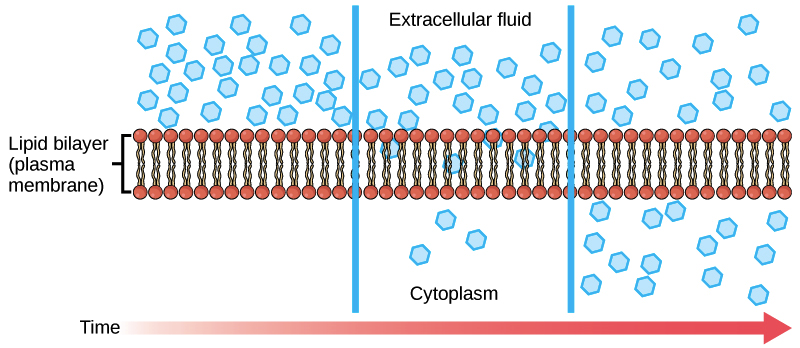Describe How Molecules Enter and Leave a Cell
A hypertonic solution has more solutes. Passive transport is the movement of molecules and ions across the cell membrane whith no use of energy it usuale involves a difussion down its concentration gradient a region where concentration changes across a membrane from higher to lower concentrations.
In vesicular transport vesicles allow large molecules to exit the cell because the vesicle fuses with the plasma membrane and its contents spill out.

. These channels only remain open for approximately one millisecond but more than 7000 sodium ions pass through into the cell in this time. Define tonicity and describe its relevance to passive transport. This is called exocytosis.
Leave a Reply Cancel reply. Through passive transport molecules move from an area of high concentration of low concentration this process is diffusion. Flagella and cilia also help with the movement of cells.
To move across the cell membrane without requiring any energy. Crossing the Membrane Small molecules such as oxygen which cells need in order to carry out metabolic functions such as cellular respiration and carbon dioxide a byproduct of these functions can easily enter and. Diffusion is possible because the cell membrane is selectively permeable semi- permeable.
Passive transport can happen by simple. Diffusion is the movement of molecules from an area where there are more of the molecules to an area where there are fewer of the molecules. Another way to describe the two solutions in the example of above is to use the terms hypertonic and hypotonic.
Through passive transport. A Describe the structure of a cell membrane. Your email address will not be published.
Phospholipids form a bilayer or double layer which makes up most of the membrane. A semi permeable selectively permeable membrane permits. Active transport indirectly requires energy from the hydrolysis of ATP.
They are both separated by a cell membrane. Passive transport is a way that small molecules or ions move across the cell membrane without the input of energy by the cell. Passive transport is performed by diffusion facilitated diffusion and transport through pores.
How molecules enter and leave a cell. Describe one similarity and. It can explain how molecules can enter and leave a cell.
Moves from high to low Active Transport moves particles through proteins. The first mechanism requires proteins embedded in the cell membrane to actively pump molecules in or out of the cell. In facilitated diffusion sodium passes through the cell membrane in a voltage-gated ion channel which is opened by a change in electrical current across the membrane.
How do molecules enter and leave a cell without the use of cells energy. Molecules of oxygen and carbon dioxide have no charge and pass through by simple diffusion. Membrane is selectively permeable allowing only certain substances to pass through.
An increase or decrease in the density of a chemical substance in an area. Your answer must include two passive and active transport methods Diffusion no energy is required. However since there is less water on the side with the sucrose water will enter the cell by osmosis.
Amino acid and glucose molecules. Phospholipids permit lipid-soluble materials to easily enter or leave the cell by diffusion through the cell membrane. Key Questions Describe how molecules enter and leave a cell without the use of the cells energy.
This requires energy which is supplied by the cells ATP. Plasma membranes must allow certain substances to enter and leave a cell while preventing harmful material from entering and essential material from leaving. Describe how food molecules enter and move through the body to the cells of a healthy person.
Transports gases and other small particles. The second mechanism called endocytosis occurs when the cell engulfs a molecule creating a vesicle that carries the molecule into the cell. Transport through cell membrane which does not require energy is called passive transport.
Watersolvent molecules travel from A across the cell membrane semi permeable membrane to B until the concentrations of A and B become equal. Like a drawbridge intended to protect a castle and keep out enemies the cell membrane only allows certain molecules to enter or exit. Identify and discuss 4 ways for substances to enter or leave cells.
Most molecules need the transport proteins to enter or leave the cell but its possible for some molecules like water to diffuse through the membrane by osmosis. Moves from high to low Osmosis no energy required. You may use a labelled diagram to support your answer.
Glucose only enters the cell by diffusion if its intracellular concentration is lower than the extracellular one. The sucrose molecules will not leave the cell because they cannot pass through the membrane. Polar substances with the.
- The cell 1. When glucose molecules move into the cell by facilitated diffusion the concentration gradient plays an essential part. The process by which the molecules enter and leave the cell is called diffusion.
Amino acid and glucose molecules. This type of facilitated diffusion of. Spreading of molecules from higher concentration to lower concentration down the concentration gradient concentration gradient.
Transported across cell membranes. Describe how food molecules enter and move through the body to the cells of a healthy person. The three main kinds of passive transport are diffusion.
When a gradient exists the ions or other substances tend to move from where. Describe how molecules enter and leave a cell without the use of the cells energy.




Comments
Post a Comment